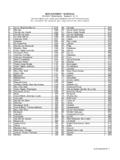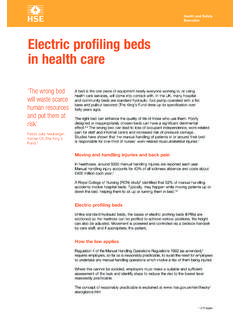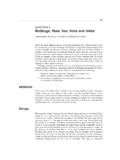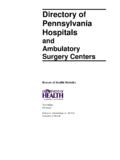Transcription of Durable Medical Equipment - docpages.com
1 Durable Medical Equipment Home bound patients usually have physical limitations that cause them to be confined to their homes. These people can often benefit from Medical Equipment that are designed for the handicapped person. You don't have to be missing a limb to benefit from Medical Equipment . Something as simple as a walker or a commode can make the difference between being bedridden and ambulatory in the house. A wheelchair or a scooter can allow an otherwise home bound person to be independent outside of the house. Some of these devices are relatively inexpensive, but others can be quite costly. Medicare and Medicaid do pay for many of these devices, but certain qualifications need to be met.
2 This guide was prepared to help you understand what kind of devices are available and what may be appropriate for your specific needs. It will also serve as a guide to help you determine if Medicare or Medicaid will cover the Equipment in your situation. Walking Aids: These devices include Canes, Quad Canes, Walkers and Crutches. These are usually covered by Medicare. Usually, a simple prescription from your doctor is all that is required to have these devices covered. One caveat is that Medicare will not pay for a device that is considered a downgrade from what you already have. For example: If you already have a walker through Medicare, you do not qualify for a cane.
3 If you have a walker, you can upgrade to a wheelchair but not the other way around. Wheelchairs: The standard wheelchair is covered in most situations where the person is unable to walk. There are specialized wheelchairs available such as lightweight, heavy duty, reclining back and motorized wheelchairs. Coverage for these specialized wheelchairs will depend upon the situation. In order for Medicare to pay for wheelchairs, your doctor will need to fill out a special form. The forms are usually supplied by the supplier. Although the doctor is expected to fill out the forms honestly, Medicare requires specific terminology when filling out the forms.
4 Physicians who are not experienced at filling out these forms may face denials of their orders and need to resubmit the forms multiple times before the order is approved. The supply companies are not allowed to fill out the form for the doctor, so the process can become frustrating both for the patient and the doctor. The motorized wheelchair in particular, is very difficult to get approved. The patient needs to be unable to walk and also needs to have a condition which prevents her from being able to operate a manual wheelchair. Upper extremity paralysis or weakness due to stroke and multiple sclerosis are some examples of conditions that would help a patient qualify for a motorized wheelchair.
5 Hospital beds : Hospital beds allow a patient to be placed in different positions such as having the head or feet elevated. The ability to adjust the height of the bed will also help the caregiver transfer and care for the immobilized patient. Again, a special form needs to be completed by the doctor to get approval for hospital beds . Hospital beds can be manual, in which case someone would have to crank a handle to change the height and position. They also come in electric and semi electric models. Most hospital beds come with side rails that help prevent a patient from falling out of the bed. Side rails that fit on to a regular bed are also available.
6 Patients who have use of their upper extremities can benefit from a trapeze that can fit onto the bed. This allows the patient to pull with his arms and position himself in the bed. Mattresses: Hosiptal beds can be fitted with special mattresses designed to prevent and heal bedsores. Although these mattresses work best to prevent ulcers, Medicare will, unfortunately, only pay if a bedsore has already developed. For superficial bedsores, a simple air mattress will alleviate load at the pressure points. For deeper more established sores (stage 3 and 4), Medicare will pay for an alternating pressure air mattress. These mattresses simulate the turning of the patient by automatically inflating and deflating different parts of the mattress thus shifting the pressure points.
7 The doctor will need to do extensive paperwork and monthly monitoring of the wounds for Medicare to continue paying for the mattress. They will stop paying once the ulcers have healed. There are other types of sophisticated bed/mattress systems which work with continuous air flow through a sand filled mattress, but these systems are extremely expensive and almost impossible to get covered by Medicare. Lifts: For the person who is unable to stand or bear weight on her legs, a Hoyer lift can be helpful in transferring from bed to chair and back. These devices are rather bulky and require some training for the caregiver to use. A sling is placed under the patient and a hydrolic jack is used to elevate the person off the bed.
8 The lift, along with the patient, is then rolled and lowered onto the chair. This sounds awkward, but once the caregiver gets used to the procedure, it saves a lot of back strain and decreases the risk of dropping the patient. Paperwork needs to be filled out by the doctor. Oxygen: Oxygen used to be delivered in large pressurized tanks, but now most companies supply oxygen concentrator machines. These machines actually create concentrated oxygen from the air and send it through tubing which can be fitted over the patient's nose or onto a mask which the patient wears over his face. Compared to the oxygen tanks, some people complain that the machines are too loud.
9 It does make a noise, but having the company supply a longer hose will allow the machine to be placed in a different room or even inside a closet to limit the noise. The concentrators are safer because there is no pressurized gas and the air will not run out. Small portable tanks can be supplied in case there is a power outage or machine malfunction. The portable tanks are also useful for short trips out of the house. There are specific criteria that need to be met for Medicare to pay for the oxygen. The patient needs to have a qualifying condition such as emphysema and the oxygen saturation at rest needs to be less than 87%. The doctor also needs to fill out the proper forms.
10 People should not smoke where oxygen is being used. Although oxygen is not itself combustible, oxygen can increase the risk of fires. Seat Lift Chairs: Seat lift chairs usually look like a normal Lazyboy reclining chair, but have a device inside that allows the patient to be lifted almost to a standing position. Theses chairs are very helpful for patients who are able to walk once they are in a standing position. The patient needs to be able to walk to qualify for this device. Medicare will only pay for the lifting device, it will not pay for the chair itself. The patient will most likely have to pay for a substantial part of the cost of the seat lift chair.






